Installations: The tools of artistic activism
Artists opting to make a social statement find the subtext of sculptural art too sterile
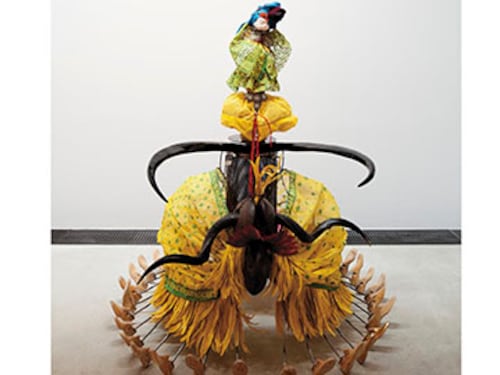

Installations are believed by many to be sculptures that got too big for their boots. But size alone cannot define them. Installations are meant to excite and provoke, turning the artist into an activist, a role they adopt to draw attention to ironies and contradictions, hypocrisies and dichotomies. The mediums are diverse and new age: Manufactured products, found objects, natural and manmade materials, sometimes supported by technology. They tend to play an important part in encouraging fresh discourse, and are best reserved for public spaces (appearing at biennales) or in museums where they engage viewers in acts of interrogation. The last decades have seen promising work by Indian artists, though the art has still to gain currency or be understood in acceptable ways by a largely art-illiterate population. Preternatural Passage
Preternatural Passage
2011
Rina Banerjee (b 1963)
Those who struggled to make sense of Surendran Nair’s titles for his works (‘Cuckoonebulopolis’, for instance) will find a sense of humour in Rina Banerjee, whose names for her installations can truly confound. The title for this work, for example, is: ‘Preternatural passage came from wet whiteness and mercantile madness, paid for circular migrations, she went thirty six directions that is all the more different, where empire threw her new born and heritage claimed as well, this lady bug was not scarlet.’ Its translation into art certainly does better with its fluid sense of animation pointing to 36 unshod feet set to strike out in all directions. The use of materials binds her to memory but also provides a window to a world where medical changes are questioning the legacy of race and superiority, amalgamating it with markets and the loss of rootedness. Based in New York, Banerjee’s works involve fantasy, pop culture and a global art that addresses notions of an environment where nothing is static.
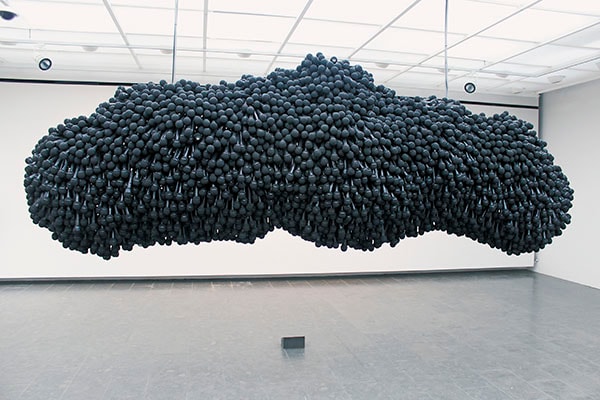 Singing Cloud
Singing Cloud
2008-09
Shilpa Gupta (b 1976)
Shilpa Gupta uses research like a surgeon’s scalpel, raises concerns about borders, militarism, trafficking and security that render nations and people apart. Her worrying political commentary is labouriously dealt with in her installations. In ‘Singing Cloud’, she takes a doomsday swirl of microphones in a tight cluster, and suspends them overhead. Reminiscent of a mushroom cloud, it is a scathing commentary on modern society where we are constantly being watched and judged. Big Brother snooping on us is something we have learnt to live with, but with technological advancements, there is no privacy any longer. Every comment or tweet is breaking news, vigilantism is turning into mob judgements and executions are leading to a talibanisation of society. With access to information accompanied by brainwashing, there is no escape from an intrusive culture that feels no remorse for feasting on private sorrow. The babble of voices that accompanies it is biblical, with none of the restraint and compassion that is at the heart of this and every book of every faith.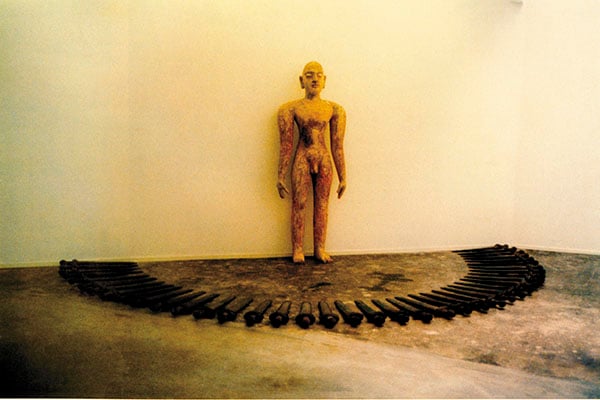 The Inner Voice
The Inner Voice
1992
NN Rimzon (b 1957)
The youth that found disillusionment in Indira Gandhi’s Emergency found a potent voice in the struggle that opposing politicians, writers, actors, filmmakers and artistes chose to express in their myriad ways. For NN Rimzon, it catapulted him to move from painting to sculpture. His attempt to grapple with the loss and alienation of human rights, and society’s claustrophobic confinement and isolation resulted in works that reflect this reality. His influence would pervade well into this century when GR Iranna portrayed a similar imagery as in this figure of a nude that is depicted in a Mahavira-like stance of renunciation. But the figure’s vulnerability comes not from its nakedness as from the half-circle of swords arranged around it, their unsheated points facing the figure. Is this society’s way of pointing fingers and daggers at individuals, or the sum of one’s own fears? Rimzon’s work provides no answers, leaving viewers to grapple with these on their own terms, similar to the way in which we must each seek solutions to social issues and ills.

Love
2006
Sudarshan Shetty (b 1961)
The artist who stunned Mumbai with his installation of a bus has this time turned his attention to a shocking installation that shows two beasts mechanised to replicate the act of love-making in a voyeuristic manner. Shetty, who shuns obvious symbolism, finds amusement in familiar scenes of domesticity that he turns into larger-than-life spectacles. His use of the vestiges of the body, particularly its skeleton—he casts these in stainless steel, moulded from real bones—to point to the absence of the body of the human conundrum of being elsewhere even in the act of making love. This grotesqueness is accentuated by the rocking motion of the assemblage, reducing the tender emotion to lust. In fact, the many manifestations of love in this series of works included an installation that showed a dinosaur copulating with a Jaguar sports car, a Braille writer typing out the word ‘love’ continuously, and a mechanical heart morphing, first into a human heart and, then into a valentine, representative of a new generation’s restless search for instant gratification. Intimations of Mortality
Intimations of Mortality
1997
Anita Dube (b 1958)
Are those eyes? Anita Dube could tell you a thing or two about being watched by Big Brother, about invasions of privacy, about loss of confidentiality. Not because she has been through a similar examination. As part of the Indian Radical Painters and Sculptors Association in Baroda and Kozhikode, she came to intellectualise art to a further degree than most, bringing politics into play, creating dialogues and discussions around her creative discourse. So what appears to be termite eating into a building turns out to be society’s canker as technology gnaws at its vitals. Dube often works with found or manufactured objects, in particular ceramic ‘eyes’ that are mass manufactured for the use of idol makers of Hindu gods and goddesses. According to her, any object has the possibility of becoming another thing or being, leading us to wonder whether the space we occupy is a mis-en-scene. Are we raised to look at things in a particular way through an indoctrination, when they could as easily be quite another? The many ways of seeing are evocatively captured in this installation that was shown at the Kiran Nadar Museum of Art in New Delhi.
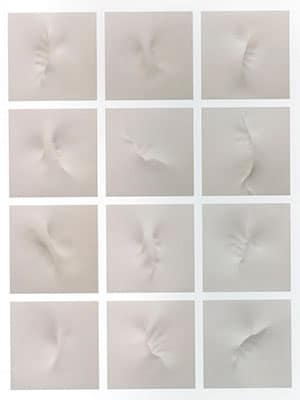 Hidden Waves
Hidden Waves
2008
A Balasubramaniam (b 1971)
what is it that separates us from the outside world? Why do we succumb to the notion of boundaries, geographies? Is there a tangible difference to the ‘inside’ and ‘outside’ of our bodies? A Balasubramaniam hands us a different way of looking at the relationship of our body with the material world, engaging with what we see and what we don’t, renegotiating the way we have been taught to look at things in a rational way. The act of appearance and disappearance—which he makes central to his work—raises philosophical questions about selfhood, society, nations and people. ‘Hidden Waves’ is Balasubramaniam at his most subtle, moving away from the obviously figurative to point to that which is suggested: Upheavals and movements under the surface that might, at any moment, break through and erupt. But which, for now, remain confined and unseen, and therefore portend doom. Playing with surfaces, Balasubramaniam achieves the impossible, making us realise that what we see is merely the surface.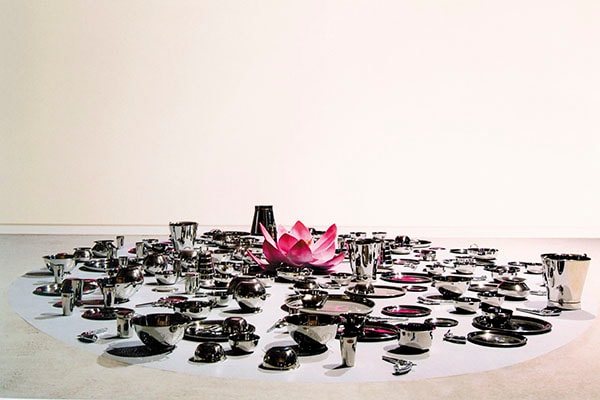 The Way Home (I)
The Way Home (I)
2000-2006
Subodh Gupta (b 1964)
This Bartanwalla is probably india’s most multifaceted artiste: A painter, photographer, installation, video and performance artiste rolled into one. His penchant for working with objects from middle-class homes—mainly steel utensils, but also yellow-top taxis and baggage at airports (symbolising migration) and cow pats (symbolising untouchability and segregation)—has been evocative. His larger installations have utilised the rudiments of Indian homes, with which he addresses issues such as poverty, hunger, nuclear armament, power and class. This work brings home a simple parable: What binds families and society together is the family kitchen where a thali becomes a symbol for all our emotions—love, belonging, selflessness, but also custom, tradition and legacy. In another edition of this work, he places a cow (a wish-fulfilling creature) in the middle. But what’s disturbing is the pistol that lies casually in the setting a reminder of how violence is as ordinary and mundane as our daily meal.
Death of Distance
2006
Jitish Kallat (b 1974)
The curator of the second edition of the Kochi Muziris Biennale and one of the more relevant of contemporary artists, Jitish Kallat’s imagery emerges from his explorations of Mumbai in the form of large installations that are as energising as they are thought-provoking. He brings urban consumerism to the fore, though his striking images suggest a deeper, darker past than a current present at first glance. While better known for his use of an anthropological language to evocatively address his concerns—creating fibre-glass ‘bones’ for cars and trucks, for instance, to depict the terror they wreak on our roads—in ‘Death of Distance’ he draws out the irony of a global economy in which the Indian rupee has played catch-up with developed economies and holds the promise and seduction of increasing materialism amidst hunger, farmer suicides and death. A large coin is surrounded by reports that comment on India’s negative indices, pointing out the dichotomy between perception and reality in a way that is rife with illusions of wealth amidst degrading poverty.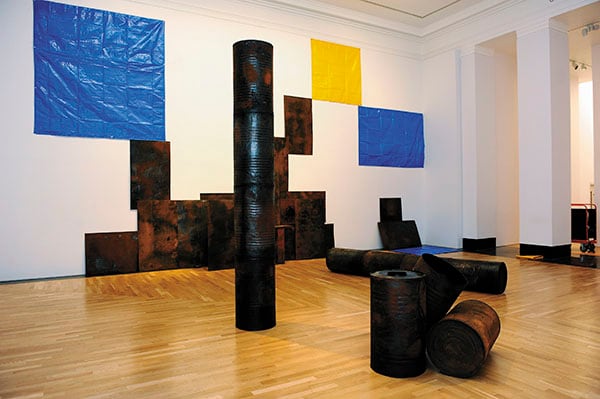 Kagebangara
Kagebangara
2008
Sheela Gowda (b 1957)
Sheela Gowda, who is also a photographer, is moved by regional uncertainties as nations ride on the testosterone of armament, border disputes, nationalism and ethnic cleansing. She uses local materials and symbolism for her narratives: Blood, hair, thread and cow dung. While these hint at her fascination with feminist myths, ‘Kagebangara’ resounds with several meanings. Its use of oil barrels and drums flattened into sheets, with plastic squares in the background, alludes to migration, with labour indentured from one part of the country to another (or one country to another) as they build roads and infrastructure, all the while finding temporary shelter, protected from the elements only by plastic sheets. If it hints at Naxal and state violence in remote areas, it also winks at acts of war and oil hegemony. In all this, the routines of life play out in the temporary shelters, counterpoising the ‘normal’ with the ‘abnormal’.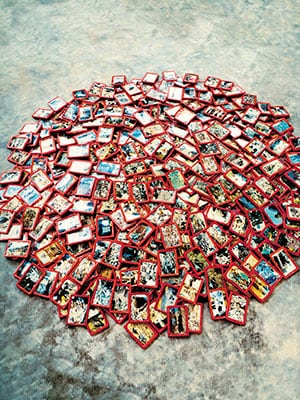 Great Indian Bazaar
Great Indian Bazaar
1997
Vivan Sundaram (b 1943)
Vivan Sundaram grew up surrounded by memories and images of his aunt, the well-known artist Amrita Sher-Gil, and was drawn to a career in art, even working on a project using pictures of her and her parents in a reimagining series. A figurative artist, Sundaram was among the earliest Indian artists to work on installations based on his perceptions of social and political reality. The consumptive nature of society and how we handle waste has always drawn him. ‘Great Indian Bazaar’ would lead him to ‘Trash’ and, ultimately, ‘Black Gold’, all based on the perception of people’s belongings, memory and clutter. In this installation, one of his earliest, he chose to create a heap of photographs in identical frames tossed into a circular pile. The photographs are of objects he found at the Red Fort chor bazaar where recycled goods can be found. Each object carries memories, each to be cast off and reclaimed in a fascinating cycle of consumption as necessity as well as indulgence.
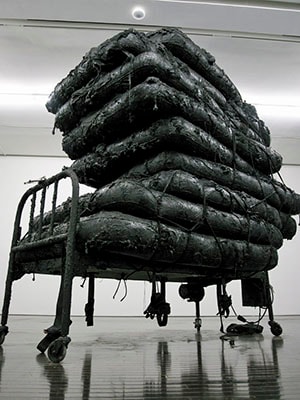 Untitled
Untitled
2007
LN Tallur (b 1971)
As an installation artist, LN Tallur draws attention to local communities and cultural continuities that turn up missing in a global world’s quest to modernise. Using elements that combine tradition with spirituality, he has linked up local issues with global concerns in a manner that draws on the aesthetic beauty of subjects that even appear grotesque. At a time when farmer suicides are rife, this Untitled work draws parallels with the social isolation of the rural poor who remain outside the purview of urban politics, even though numerous schemes are supposed to alleviate their condition. In this hospital bed piled high with sordid, old, used mattresses that are tethered together, Tallur has recreated the mattresses using a synthetic material. Viewers can see the mattresses deflate and inflate, accompanied by the sound of a heart machine, as if the very lungs of farmers are being squeezed of their last breath. This ability to comment on social arrangements and their unviability creates a stage for horror that goes unnoticed by most who dwell in cities, cut off from a ‘real’ India that resides somewhere in the vast unknown.
First Published: Jun 05, 2015, 07:39
Subscribe Now(This story appears in the Jun 18, 2010 issue of Forbes India. To visit our Archives, Click here.)